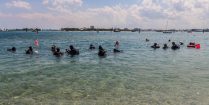Nothing can ruin a dive day quicker than a bout of seasickness. Whether your someone who is typically susceptible to motion sickness or just caught off guard in topsy-turvy sea conditions, needing to cope with seasickness can happen to anyone.
Seasickness, or motion sickness as it’s also called, is an inner ear disorder that causes nausea, dizziness and even vomiting. This condition happens when there is an imbalance between the eyes, inner ears, and spinal cord.
Typically this ill-feeling condition happens to people when they are in a car, airplane or on a boat.

If you’ve suffered from motion sickness, you know how debilitating it can be. Add that to an intensive day of diving, and it can be pretty rough.
Here are five strategies to help you deal with motion sickness before and during a dive adventure.
If you are someone who is prone to seasickness or you notice that the forecast is going to be particularly rough on dive day, make a pit stop at the pharmacy.
Taking over the counter medications such as Dramamine or Bonine can undoubtedly alleviate the need to vomit sensation, but many of these need to be taken 12 hours or more before you plan on hitting the water.

Divers need to be aware that some of the anti-nausea drugs can induce drowsiness and affect every person differently.
Additional Information: To deal with seasickness and diving, we use a motion sickness patch called Transderm Scop. The patch is a little on the expensive side, but it works for three days. We apply the patch just behind our ear, and it slowly releases medication that enables our bodies to better deal with motion sickness. While the patch sometimes can create drowsiness, we have never had any issues with drowsiness and diving.

Generally speaking, it is never good to dive on an empty stomach so make sure you are eating before heading out on the dive boat.
Be conscientious of the types of foods you are consuming and try to keep it light.
Fried food, spicy food, rich food are all hard to digest foods and can worsen the feeling of motion sickness and increase the chances that you throw up. If you are someone who often gets motion sickness try to stick to simple foods such as chicken noodle soup, bagels, and crackers before and on dive day.
To drink – hydrate up with clear liquids like ginger ale. That will make your tummy a happy camper.

Sounds romantic right? Okay, maybe not when you feel queasy…
When people get hit with motion sickness, their first instinct is usually to close their eyes and lay down. Some even head below deck if the option is there.
To try and get rid of seasickness we recommend doing the opposite.
The last place you want to be if you are feeling sick is below deck. Stay out in the fresh air. Try to seat yourself towards the stern of the boat and reorient your inner ear by looking off into the distance in the direction the boat is moving. Avoid looking at things on the boat and gaze instead out at the horizon.

Medication is not the only way to lessen seasickness; there are also some natural remedies for seasickness.
Peppermint and ginger are two handy products to have with you on a boat dive trip. Whether you’re sucking on a mint leave or sucking on some candied ginger, the antiemetic and antispasmodic properties, make these natural remedies a diver’s best friend on a rough dive day.

Sometimes when you need to throw up, the best policy is to not to try and hold it in. In the words of my favorite Disney Frozen character Elsa; “Let it go, let it go!”
Having been there ourselves we know it can be embarrassing, especially if you are the only one seasick on the boat, but trust me when I say this you will feel a lot better after vomiting.

Of course, this is our favorite solution to motion sickness; do more diving!
The more you dive, the more comfortable you will be on the boat and in the water.
When you’re stricken with motion sickness, it’s common for people to want to avoid the water. In some instances, it’s the appropriate choice, but most of the time a diver will feel better once they are away from the rocking and pitching of the boat.
Motion sickness, sea sickness, whatever you want to call this unpleasant condition, it sucks! When it hits, it hits hard and can turn your world upside down.
While these tips may not entirely rid you of your nauseated need-to-vomit state of being, they will hopefully help you mitigate you seasickness and at least salvage your dive day.

Are you one of those people that can’t shake seasickness no matter what conditions you dive in? What is your best remedy to beat that queasy nauseated sensation in the pit of your stomach?
Writers Note: This post may contain affiliate links. We will make a small commission if you make a purchase through one of these links, at no extra cost to you. See full disclosure and disclaimer policy here.


Everybody loves the idea of scuba diving, but the aspect of post dive cleanup is a much different story. It’s long, it’s tedious and it almost impossible to do it without getting wet - yet again.

Organizing a dive vacation can be a challenge. To help, keep these four questions in mind when planning your next scuba diving vacation.

Many scuba diving agencies that play a role in training divers. Here is a look at SEI, PADI, NAUI, and SSI, the top scuba agencies in the world.

If you are a scuba diver looking to get married on your surface interval here are some nifty ocean related idea's to incorporate into your special day.

It's not easy being green in a day and age where everything is plastic and waste. Let sustainability lead the way as you explore the underwater world.

Sometimes a dive doesn’t go according to plan and when that happens, it’s important to be seen. Learn all about surface markers and why you should have one.

Are you a pig on air? You are not alone. Find out how you can get more out of your scuba diving tank.

Hair versus scuba, now that's a combination that doesn't mix. So how do you stay away from the tares, tangles and hours upon hours of post-dive hair brushing?

No matter what level of diver you are, scuba backroll entries are a fun-filled way to get off the dive boat and get into the water.

Fluodiving, fluorescent night diving, UV diving, glow diving - goes by many names. But no matter what you call this vibrant type of diving, the optical magic of fluorescence adds a totally new dimension to your night diving repertoire.
